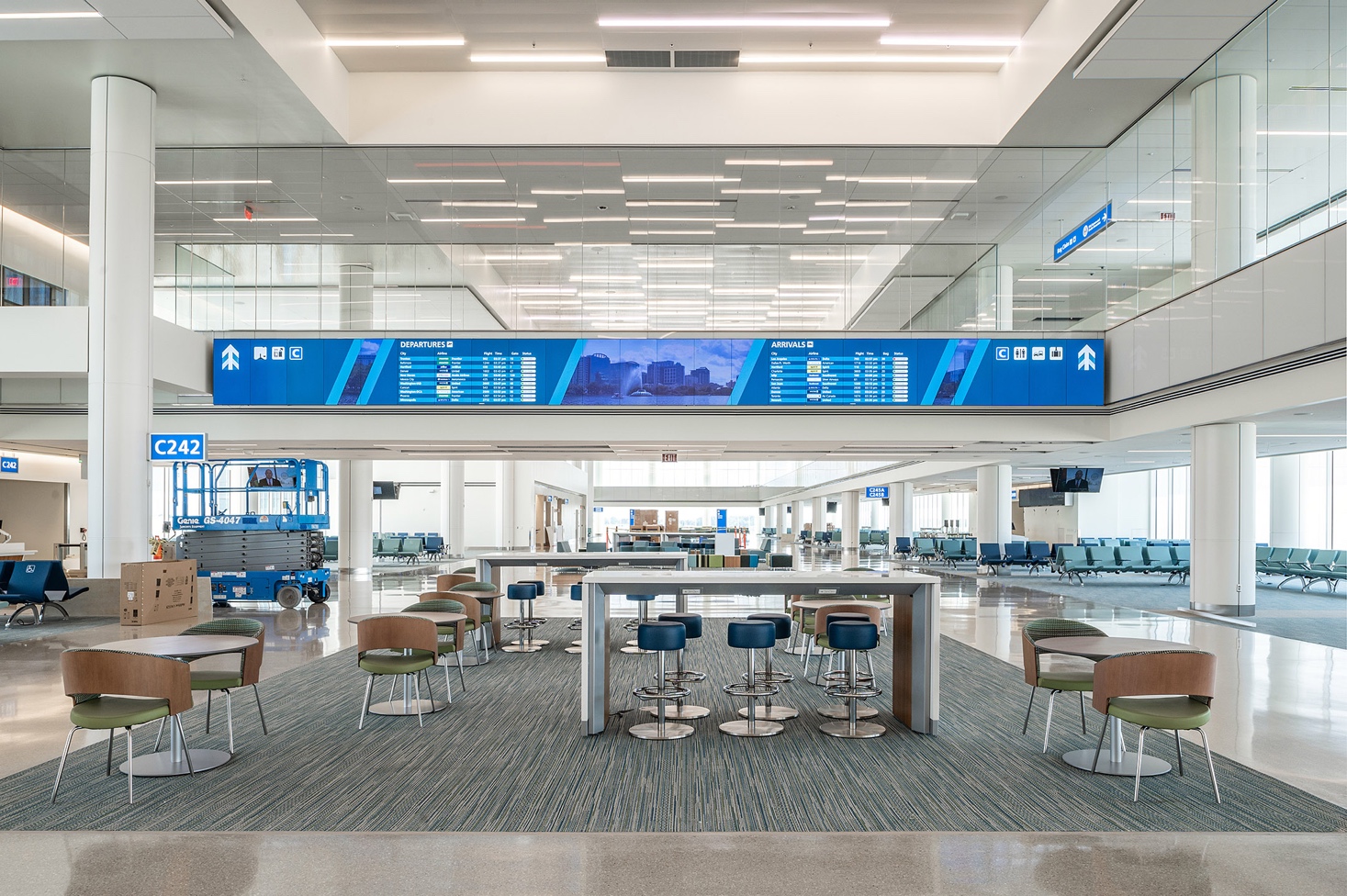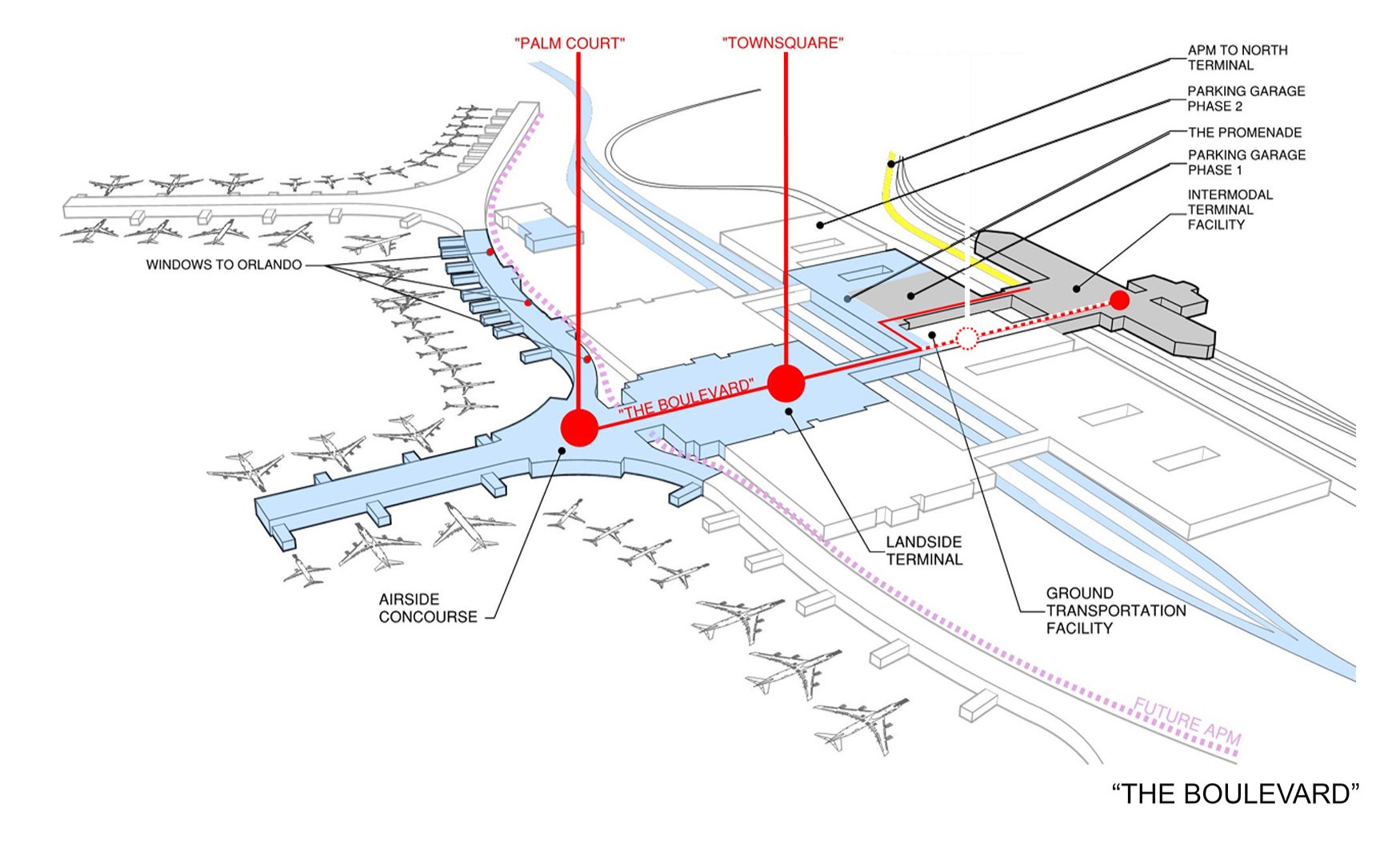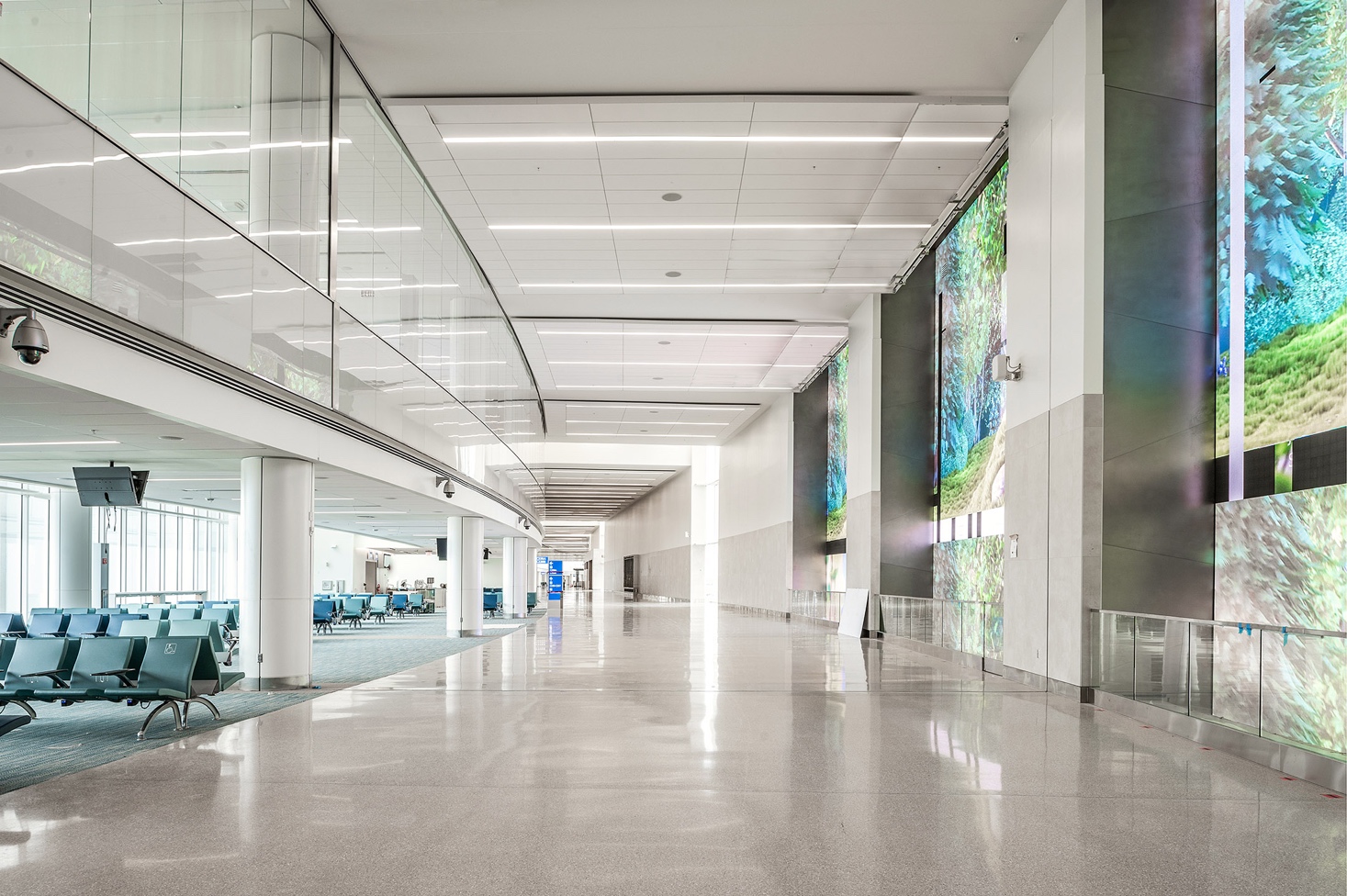World-Class Design for MCO’s New Terminal C
Orlando International Airport (MCO) is the gateway to Central Florida’s thriving business community, theme parks including the Walt Disney World Resort, miles of spectacular beaches and NASA’s Kennedy Space Center.
Terminal C will introduce the next generation of The Orlando Experience®. Terminal C builds upon the established MCO aesthetic of air, water and sky. It includes a seamless, low-touch environment that offers an exciting combination of concessions, interactive media displays and iconic architecture. Upon opening, Terminal C will serve up to 12 million passengers annually. It will also feature a new Federal Inspection Service (FIS) facility as well as 15 new gates (accommodating up to 20 aircraft). Amenities will include a nursing station and pet relief areas. At full build out, Terminal C can increase capacity at MCO up to 60 million passengers annually.
“This summer MCO will debut the new Terminal C, which is designed to support growing passenger volume and reinforce the airport’s reputation for excellence in traveller satisfaction,” said Curtis Fentress, FAIA Principal in Charge of Design with design architect Fentress Architects.

Elevating The Orlando Experience® with Iconic Architecture
Design architect Fentress Architects, together with HNTB as architect of record, designed Terminal C to be an iconic gateway to the entire region.
“An airport should be reflective of the environment and region it serves as well as meet the needs of its passengers. For Orlando, that means architecturally identifying with subtropical vegetation and wildlife as well as numerous world-classattractions. It also means understanding a very diverse passenger profile; each with their own unique expectations of the Orlando Experience. Terminal C will offer passengers the best in technology and operations, and also a very friendly, hospitable environment,” said Fentress.
Among the terminal’s signature architectural elements is The Prow. It sets an uplifting tone at curbside, especially when seen against a dramatic Florida sky. Ambient natural light will flow in from this curbside curtainwall, as well as from the Terminal’s skylit spine. This will help bring the outdoors in and guides passengers to world-class amenities and onto their gate.
“Innovation and sophisticated design that reflects elements of the Central Florida community combine to deliver a world-class travel experience,” says Kevin Thibault, CEO, Greater Orlando Aviation Authority. “Terminal C will be so much more than a transfer point from one place to another. It will serve as a multimodal memorable entryway for passengers visiting, living and working in the region.”
All major building elements—ticketing, security, concessions, gates and baggage claim—will be aligned along a Boulevard. This will lead passengers on a linear journey. A Grand Skylight that introduces dappled daylight and supports lush foliage will adorn this Boulevard.
“The tinted glass panels of the Grand Skylight dapple and diffuse sunlight, which creates an effect reminiscent of light coming through Orlando’s historic orange groves,” said Fentress.
The Boulevard will also connect Terminal C’s two signature civic spaces—Palm Court and Town Square—with the MCO’s Intermodal Terminal Facility. The Facility supports up to four rail systems, including Brightline’s inter-city service. Palm Court is located airside, at the terminus of the Boulevard skylight. It is the grandest of Terminal C’s civic spaces. As such, this vibrant location will feature shopping, experiential media, dining, socializing and relaxation lounges in a daylit, garden-like atmosphere. The design of second-story retail and lofted airline clubs means they will overlook Palm Court and its experiential media element, which will feature an interactive exploration of Orlando’s various destinations.
Meanwhile, Town Square is located landside, at the terminus of an elevated international arrivals corridor. This light-filled, spacious arrivals hall on the terminal’s upper-most level will provide a stark contrast to the buried baggage claims found in so many other airports. It is imbued with a sense of welcoming and openness to enhance the international and domestic passenger experience.
© Fentress Architects
Uplifting Experiences: Arrival & Departure
With the help of recently developed baggage conveyance technology, Terminal C will reverse the traditional paradigm of arrivals on the lower level and departures on the upper level. Passengers arriving—often from long flights—will be directed to a unique and uplifting experience: the upper-most level of the terminal. Awash in filtered Central Florida sunlight with majestic views of the local natural environment, this immediate and immersive experience will at once orient travelers to both Orlando and the United States. Easy access to restrooms and concessions, in a pleasant environment, will further cater to travelers innate needs.
Departing travelers will have a similarly pleasant experience. Flexibility is the intention for everything from intuitive parking and drop-off areas to a new ticketing hall. Additionally, they are outfitted with kiosks and outstanding customer service representatives. Security will be similarly intuitive, orderly and responsive.

Interactive Media
An Experiential Media Environment (EME) has been seamlessly integrated into the terminal’s architecture. All three EME elements specifically serve to celebrate the region’s dynamic identity. They also highlight for visitors the robust offerings of Central Florida’s natual and developed attractions.
- Moment Vault, located in Palm Court, offers departing passengers a 360-degree immersive experience. The Vault combines silhouettes gathered from strategically placed cameras located throughout the space with striking video footage from local points of interest. Highlights in the 23 capsules that run 109 minutes include underwater play in deep blue springs with a school of bioluminescent fish and an excursion to the surface of Mars where red rocks have a life of their own.
- The Portal, located in Town Square (also known as the arrivals hall), rises three-stories high. 32 custom curved screens suspended in a helical frame comprise the feature. Synchronized content plays on both interior and exterior screens, offering 26 capsules that run 125 minutes and tell a visual story of the transformation of Central Florida from natural springs and ranchlands to the dawn of Disney, the launch into space exploration and a bounty of entertainment opportunities.
- Windows on Orlando, located along the airside concourse, is a 100-foot-long, 32-foot-tall display comprised of three adjacent, panoramic screens. Select Central Florida locations were captured in 20 capsules that run 79 minutes. Highlights include a rocket launch sequence filmed from the NASA Vehicle Assembly Building at the Kennedy Space Center and an afternoon ride under open skies to round up cattle with cowhands at the Deseret Ranch in St. Cloud.
Hi-Tech, Low Touch
An increasingly touchless experience will bolster international and domestic passenger growth at MCO. Touchpoints, also known as points of contact or interaction, occur at check-in, security, concessions, boarding, customs and more. These have long been hallmarks of the passenger experience. That said, over the past few decades, airport planners and designers have helped lessen the time spent at touchpoints. In doing so, they have made the airport experience both more efficient and pleasant.
Terminal C has the design of a linear/pier configuration. This minimizes transit times for departing passengers to an average of eleven minutes. Additionally, Terminal C will engage a variety of biometric devices including:
- 100-percent automated screening lanes in TSA checkpoint.
- 100-percent facial recognition at all 15 gates for international arrival and departures.

Sustainable Design
Terminal C will be as sustainable as possible thanks to a long list of design strategies. Strategies include the deployment of reduced water-consumption and irrigation systems, responsive lighting and temperature control systems. Also involved are solar panels, non-toxic adhesives and non-painted natural materials. Together, these and other strategies are likely to support an award of Silver or Gold LEED Certification by the US Green Building Council. If awarded, Terminal C will be the first LEED®v4 airport campus of any level in the world.